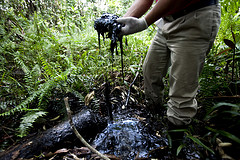Rupert Murdoch’s Wall Street Journal recently published an article entitled “Shakedown in the Rain Forest.” The piece’s bias is blatant. You need a subscription to read the whole thing, but click here and check out the teaser. Clearly the WSJ is okay with simply regurgitating Chevron’s talking points.
 This is the third time the WSJ has published a hit piece against the ongoing trial in Ecuador, as Jonathan Abady wrote in his letter to the editor. Abady is one of the lawyers who is attempting to hold Chevron accountable for the billions of gallons of toxic oil waste the company left behind in Ecuador on behalf of the 30,000 Ecuadorians who are still exposed to that toxic mess.
This is the third time the WSJ has published a hit piece against the ongoing trial in Ecuador, as Jonathan Abady wrote in his letter to the editor. Abady is one of the lawyers who is attempting to hold Chevron accountable for the billions of gallons of toxic oil waste the company left behind in Ecuador on behalf of the 30,000 Ecuadorians who are still exposed to that toxic mess.
Abady’s letter sets the record straight. The WSJ doesn’t have a unique URL for it, though, so I wanted to reproduce it here in its entirety:
Chevron Should Pay for Its Pollution in Ecuador
Your editorial “Shakedown in the Rain Forest” (Sept. 23) on Chevron’s multibillion-dollar liability in Ecuador is the third time in recent years that you have attacked this important litigation. Contrary to what you claim, scientific evidence from experts demonstrates that Chevron has been contaminating an area in Ecuador the size of Rhode Island and taking advantage of indigenous groups for decades. Now Chevron is trying to sabotage a seven-year trial to evade accountability.
Rather than deal with the overwhelming evidence of its contamination, Chevron has launched a strategy of intimidation, distraction and delay. It has filed legal actions in 10 different U.S. federal courts against 23 people (including two lawyers) involved in the case, claiming ex parte contacts with a court expert constitute “fraud.” Chevron knows that such contacts were allowed by the court and were common practice by both parties. Chevron devised this narrative as part of a strategy to defeat enforcement of a potentially adverse judgment.
From 1964 to 1990, Chevron deliberately dumped billions of gallons of toxic “formation water” into streams and rivers which thousands of people in the rain forest relied on for their drinking water. This hot liquid had a saline content 10 times higher than ocean water and contained heavy metals and carcinogens. Laboratory samples submitted during the trial found that all of the company’s former well sites are extensively contaminated— often at levels hundreds of times higher than Ecuadorian and U.S. norms. The disaster is larger than the BP Gulf spill and will cause harm for decades if not cleaned up.
Several peer-reviewed health evaluations have found significantly elevated rates of cancer where Chevron operated. Daniel Rourke, formerly associated with the Rand Corp., has found that up to 10,000 Ecuadorians are at significant risk of contracting cancer in the coming decades. Ann Maest, a leading geochemist, found that many Chevron pit sites “still contain high levels of . . . petroleum hydrocarbon contaminants” and are in close proximity to wells used for drinking water.
The editorial also mischaracterizes Chevron’s so-called “remediation” in the mid-1990s. Chevron employed a laboratory method that produced artificially low measurements of toxins that were used to induce the government to grant a release. As a result, two Chevron employees and several former Ecuadorian officials face fraud charges in Ecuador. Chevron’s internal audits conducted in the early 1990s found that remediation was necessary “at all production facilities,” that toxic wastes were not treated and that oil spills “were not cleaned up.” Yet Chevron never conducted a single environmental or health-impact study during the 26 years it operated in Ecuador.
Chevron for years insisted on moving the litigation to Ecuador after it was filed in U.S. federal court in 1993. With the evidence against it mounting, Chevron needs to stop forum shopping and allow Ecuador’s courts to determine the extent of its responsibility for this disaster.
Jonathan S. Abady
Attorney for Ecuadorian plaintiffs
New York